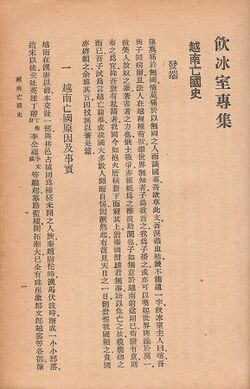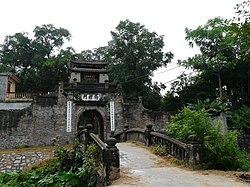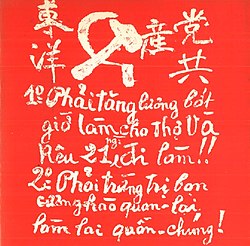Social:Chữ Hán
This article possibly contains synthesis of material which does not verifiably mention or relate to the main topic. (October 2022) (Learn how and when to remove this template message) |
| Chữ Hán | |
|---|---|
 Chữ Hán (chữ Nho, Hán tự) written in chữ Hán, mixed Hán-Nôm, with Chữ Quốc ngữ in ruby | |
| Type | Logographic
|
| Languages | Old Vietnamese, Literary Chinese, Vietnamese |
Time period | 3rd Century BC – 20th Century AD |
Parent systems | |
Child systems | Chữ Nôm |
Sister systems | Kanji, Hanja, Zhuyin, traditional Chinese, simplified Chinese, Khitan script, Jurchen script, Tangut script, Yi script |
Chữ Hán[1] (𡨸漢, literally "Han characters", Vietnamese pronunciation: [t͡ɕɨ˦ˀ˥ haːn˧˦]), chữ Nho (𡨸儒, literally "Confucian characters", Vietnamese pronunciation: [t͡ɕɨ˦ˀ˥ ɲɔ˧˧]) or Hán tự[lower-alpha 1] (漢字, Vietnamese pronunciation: [haːn˧˦ tɨ˧˨ʔ]), are the Vietnamese terms for Chinese characters, used to write Literary Chinese (Known as Hán văn 漢文 or văn ngôn 文言 in Vietnamese) and Sino-Vietnamese vocabulary in Vietnamese language, was officially used in Vietnam after the Red River Delta region was incorporated into the Han dynasty and continued to be used until the early 20th century (111 BC – 1919 AD) where usage of Literary Chinese was abolished alongside the Confucian court examinations.
History
After the conquest of Nányuè (Chinese: 南越; Vietnamese: Nam Việt), parts of modern day Northern Vietnam were incorporated into the Jiāozhǐ province (Chinese: 交趾; Vietnamese: Giao Chỉ) of the Hàn dynasty. It was during this era, that the Red River Delta was under direct Chinese rule for about a millennium. Around this time, Chinese characters became widespread in Northern Vietnam. Government documents, literature, and religious texts such as Buddhist sutras were all written in Literary Chinese (Vietnamese: Hán văn).[2] From independence from China and onward, Literary Chinese still remained as the official language for writing whether if it was government documents or literature. While literature in Vietnamese (written with chữ Nôm) was the minority. Literature such as Nam quốc sơn hà (Literary Chinese: 南國山河) and Long thành cầm giả ca (Literary Chinese: 龍城琴者歌) being written with Chinese characters. With every new dynasty with the exception of two dynasties, Literary Chinese and thus Chinese characters remained in common usage.
It was until in the 20th century that Chinese characters alongside chữ Nôm began to fall into disuse. The French Indochinese administration sought to civilise and modernise Vietnam by abolishing the Confucian court examinations. During this time, the French language was used for the administration. The French officials favoured Vietnamese being written in the Vietnamese alphabet.
Today, Chinese characters can still be seen adorned in temples and old buildings. During Tết, some couplets will be written in Chinese characters wishing prosperity and longevity.
Names
In Vietnam, many provinces and cities have names that come from Sino-Vietnamese words and were written using Chinese characters. This was done because the government administration needed to have a way to write down these names, as native names didn't have characters. Even well-known places like Hanoi (河內) and Huế (化) were written in Chinese characters. Often, villages only had one word names in Vietnamese.
Some Sino-Vietnamese names were translated from their original names, like Tam Điệp Quan (三疊關) being the Sino-Vietnamese name for Đèo Ba Dội.
| Chinese characters | tên Chữ (Sino-Vietnamese name) | tên Nôm (Vietnamese name) |
|---|---|---|
| 河內 | Hà Nội | Kẻ Chợ |
| 紅河 | Hồng Hà | Sông Cái |
| 嘉定 | Gia Định | Sài Gòn |
| 傘園山 | Tản Viên Sơn | Núi Ba Vì |
Practically all surnames in Vietnamese are Sino-Vietnamese words, they were once written in Chinese characters. Such names include Nguyễn 阮, Trần 陳, Lê 黎, Lý 李, etc.[lower-alpha 2]
Readings for characters
Owing to historical contact with Chinese characters before the adoption of Chinese characters and how they were adapted into Vietnamese, multiple readings can exist for a single character. While most characters usually have one or two pronunciations, some characters can have up to as many as four pronunciations and more. An example of this would be the character 行 hàng – which could have the readings hàng, hành, hãng, hạng, and hạnh.[3][lower-alpha 3] The readings typically depend on the context and definition of the word. If talking about a store or goods, the reading hàng would be used, but if talking about virtue, the reading hạnh would be used. But typically, knowing what readings was not a large problem due to context and compound words. Readings for chữ Hán, often classified into Sino-Vietnamese readings and Non-Sino-Vietnamese readings. Non-Sino-Vietnamese readings are derived from Old Chinese and recent Chinese borrowings during the 17th–20th centuries when Chinese people migrated to Vietnam.[4] Most of these readings were food related as Cantonese Chinese had introduced their food into Vietnam. Borrowings from Old Chinese are also referred to as Early Sino-Vietnamese pronunciations according to Mark Alves.[5]
Sino-Vietnamese readings[6]
Sino-Vietnamese readings are usually referred to as âm Hán Việt (音漢越; literally "sound Sino-Vietnamese"), which are Vietnamese systematic pronunciations of Middle Chinese characters.[7] These readings were largely borrowed into Vietnamese during the late Tang dynasty (618-907). Vietnamese scholars used Chinese rime dictionaries to derive consistent pronunciations for Chinese characters.[8] After Vietnam had regained independence, its rulers sought to build the country on the Chinese model, during this time, Literary Chinese was used for formal government documents.[9] Around this, the Japanese and Koreans also borrowed large amount of characters into their languages and derived consistent pronunciations, these pronunciations are collectively known as the Sino-Xenic pronunciations.[7]
| Chinese
(Old > Middle) |
Early Sino-Vietnamese | Sino-Vietnamese |
|---|---|---|
| 味 *mjəts > mjɨjH | mùi 'smell, odor' | vị 'flavor, taste' |
| 婦 *bjəʔ > bjuwX | vợ 'wife' | phụ 'woman' |
| 法 *pjap > pjop | phép 'rule, law' | pháp 'rule, law' |
| 劍 *kams > kɨɐmH | gươm 'sword' | kiếm 'sword' |
| 鏡 *kraŋs > kˠiæŋH | gương 'mirror' | kính 'glass for windows, etc; eyeglasses' |
| 茶 *rlaː > ɖˠa | chè 'tea or a dessert soup' | trà 'tea' |
| 車 *kʰlja > t͡ɕʰia | xe 'wheeled vehicle' | xa 'rare form of xe' |
| 夏 *ɡraːʔ > ɦˠaX | hè 'summer' | hạ '(literary) summer' |
| Chinese characters | Standard Chinese | Cantonese | Sino-Vietnamese | Sino-Japanese | Sino-Korean |
|---|---|---|---|---|---|
| 準備 'to prepare' | zhǔnbèi | zeon2bei6 | chuẩn bị | junbi | junbi |
| 電話 'telephone' | diànhuà | din6waa6-2 | điện thoại | denwa | jeonhwa |
| 四 'four' | sì | sei3, si3 | tứ, tư | shi | sa |
| 人民 ' people' | rénmín | jan4man4 | nhân dân | jinmin | inmin |
| 地名 'place name' | dìmíng | dei6meng4-2 | địa danh | chimei | jimyeong |
| 言語 'language' | yányǔ | jin4jyu5 | ngôn ngữ | gengo | eoneo |
| 中國 'China' | Zhōngguó | Zung1gwok3 | Trung Quốc | Chūgoku | Jungguk |
| 日本 'Japan' | Rìběn | Jat6bun2 | Nhật Bản | Nihon | Ilbon |
Non-Sino-Vietnamese readings
Non-Sino-Vietnamese pronunciations are pronunciations that were not consistently derived from Middle Chinese. Typically these readings came from Old Chinese, Cantonese, and other Chinese dialects. A lot of these pronunciations came from recent Cantonese migration to Vietnam during the 17th–20th centuries.[4] Most of the Cantonese eventually settled down in Chợ Lớn,[10] and they introduced their cuisine to Vietnam. Thus, many Cantonese borrowings in Vietnamese are food-related.
| Chinese characters | Cantonese | Teochew | Vietnamese borrowing | Sino-Vietnamese |
|---|---|---|---|---|
| 豉油 'soy sauce' | si6 jau4 | xì dầu | thị du | |
| 點心 'dim sum, Cantonese food' | dim2 sam1 | điểm sấm | điểm tâm | |
| 雲吞, 餛飩 'wonton' | wan4 tan1, wan4 tan4-1 | vằn thắn, hoành thánh | vân thôn, hồn đồn | |
| 燒賣 'shumai' | siu1 maai6-2 | xíu mại | thiêu mại | |
| 臘腸 'Chinese sausage; lap cheong' | laap6 coeng4-2 | lạp xưởng | lạp tràng/trường | |
| 蝦餃 'har gow' | haa1 gaau2 | há cảo | hà giảo | |
| 水圓 'tangyuan' | seoi2 jyun4 | sủi dìn | thuỷ viên | |
| 叉燒 'char siu' | caa1 siu1 | xá xíu | xoa thiêu | |
| 酸梅 'smoked plum' | syun1 mui4 | xí muội | toan mai | |
| 香港 'Hong Kong' | hoeng1 gong2 | Hồng Kông | Hương Cảng 'dated name' | |
| 我愛你 'I love you' | ngo5 oi3 nei5 | ngộ ái nị 'humorous, is rarely used' | ngã ái nhĩ | |
| 薄餅 'popiah' | boh8 bian2 | bò bía | bạc bánh | |
| 粿條 'kuyteav' | guê2 diou5 | hủ tiếu | quả điều | |
| 爐 'hotpot' | lou5 | lẩu | lô | |
| 仙草 'grass jelly' | siêng1 cao2 | sương sáo | tiên thảo |
Nôm readings[11]
Sometimes, characters that were phonetically close to a native Vietnamese word would be used as a chữ Nôm character.[12] Most chữ Hán characters that were used for Vietnamese words were often used for their Sino-Vietnamese pronunciations rather than their meaning which could be completely different from the actual word being used. These characters were called chữ giả tá, due to them being borrowed phonetically. This was one reason why it was preferred to create a chữ Nôm character rather than using a chữ Hán character causing confusion between pronunciations.
| Chinese character and Standard Chinese pronunciations | Sino-Vietnamese pronunciations | Sino-Vietnamese meaning | Nôm pronunciations | Nôm meaning |
|---|---|---|---|---|
| 些 'xiē' | ta, tá | some; a few; a little; a bit | ta[13] | I, me, we |
| 朱 'zhū' | chu, châu | cinnabar; vermilion | cho[14] | to give, to let, to put; for |
| 別 'bié' | biệt | to divide; to separate | biết[15] | to know |
| 碎 'suì' | toái | shattered; fragmented; shredded | tôi[16] | I, me |
| 羅 'luó' | la | net for catching birds | là[17] | to be, is |
| 嘲 'cháo' | trào | to ridicule; to deride; to scorn; to jeer at | chào[18] | hello, bye |
Types of characters
Chữ Hán can be classified into the traditional classification for Chinese characters, this is called lục thư (六書, Chinese: liùshū), meaning six types of Chinese characters.
- Chữ chỉ sự (𡨸指事) – Ideogram, an example would be 上 (thượng, “above”) and 下 (hạ, “below”).
- Chữ tượng hình (𡨸象形) – Pictogram, an example would be 日 (nhật, "sun") and 木 (mộc, "tree").
- Chữ hình thanh (𡨸形聲) – Phono-semantic compound, an example would be 地 (địa, "earth") which is made up of phonetic 也 (dã) and semantic 土 (thổ, "land").
- Chữ hội ý (𡨸會意) – Compound ideographs, an example would be 明 (minh, "bright") which is made up of 日 (nhật, "sun") and 月 (nguyệt, “moon”).
- Chữ chuyển chú (𡨸轉注) – Derivative cognates, characters that were derived from other characters with similar meaning, an example would that 老 (lão, "old") is a cognate of 考 (khảo, "to examine").
- Chữ giả tá (𡨸假借) – Phonetic loan, an example would be 法 (Pháp, "France") is used for the name of France. Other European countries are also referred by a chữ giả tá like 德 (Đức, "Germany") and 意 (Ý, "Italy").
Simplification
Some chữ Hán characters were simplified into variants of characters that were easier to write, but they are not the same simplified characters used by current-day Chinese. This means that Vietnamese simplified characters may differ from Chinese simplified characters, for example, the word 羅 is simplified into 罗 in Chinese, but it is different in Vietnamese, 𱺵 (⿱罒𪜀).[19]
Another example would be the character 沒 which is simplified into 没 in Chinese and 𠬠 (⿱丷又) in Vietnamese.[20]
Some characters matching Simplified Chinese do exist, but these characters are rare in Vietnamese literature.
Symbols
The character 匕 chuỷ is often used as a iteration mark to indicate the current chữ Hán character is to be repeated. This is used in words that use reduplication. Such as in the poem Lục Vân Tiên,[21] the character 埃 (ai) is repeated twice in third line of the poem. It is written as 埃匕 to represent 埃埃 (ai ai).
| Chữ Quốc ngữ "Who who quietly listens?" | ||||||||||||
|---|---|---|---|---|---|---|---|---|---|---|---|---|
|
The way the marker is used, is very similar to how Chinese and Japanese use the iteration marker 々 (which was also historically used). Japanese uses 々 as an iteration marker, like for example, 人人 (hitobito) would be written as 人々 (hitobito).
See also
- Chữ Nôm
- Literary Chinese in Vietnam
- History of writing in Vietnam
- Chinese characters
- East Asian cultural sphere
- Kanji – Japanese equivalent of Chinese characters
- Hanja – Korean equivalent of Chinese characters
- Sino-Vietnamese vocabulary
Notes
- ↑ Hán tự is an uncommon term for Chinese characters. In late 19th-early 20th century and current-day Vietnamese, chữ Hán, along with chữ Nho and chữ Tàu, have been the dominant terms for "Chinese characters"
- ↑ Native names do exist, but are rare. Some examples include Giỏi, Sen, Gái, Nễ, etc.
- ↑ This is not including Nôm readings such as hàng, hành, hăng, and ngành.
References
- ↑ The Routledge Handbook of Translation and Politics. Routledge. April 26, 2018. p. 511. ISBN 978-1138657564. https://books.google.com/books?id=MUxWDwAAQBAJ&dq=History+of+Chinese+characters+in+Vietnam&pg=PA511. "Discussing the history of translation in Vietnam without mentioning the history of the Vietnamese written languages would be a mistake because the systems of written language in Vietnam passed through three stages: Chữ Hán (Chinese characters), Nôm (ideograms specific to Vietnam) and Chữ quốc ngữ (modern Vietnamese, written using adapted Latinate scrpit."
- ↑ Handel, Zev (2019). Sinography: The Borrowing and Adaptation of the Chinese Script. BRILL. pp. 125. ISBN 9789004386327.
- ↑ "Tra từ: 行 – Từ điển Hán Nôm". https://hvdic.thivien.net/whv/%E8%A1%8C.
- ↑ 4.0 4.1 Trần, Khánh (1993). The Ethnic Chinese and Economic Development in Vietnam. Institute of Southeast Asian Studies. ISBN 9789813016675.
- ↑ Alves, Mark (2017). "Identifying Early Sino-Vietnamese Vocabulary via Linguistic, Historical, Archaeological, and Ethnological Data". Bulletin of Chinese Linguistics.
- ↑ Shimizu, Masaaki. "A Reconstruction of Ancient Vietnamese Initials Using Chữ Nôm Materials". NINJAL Research Papers: 135. https://cir.nii.ac.jp/crid/1390853649697984768?lang=en.
- ↑ 7.0 7.1 Norman, Jerry (1988). Chinese. Cambridge University Press. ISBN 978-0-521-29653-3.
- ↑ Alves, Mark (2009). Loanwords in Vietnamese. De Gruyter Mouton. ISBN 978-3-11-021843-5.
- ↑ DeFrancis, John (1977). Colonialism and language policy in Viet Nam. Mouton. ISBN 978-90-279-7643-7.
- ↑ Shodhganga. Socio-Economic Background of the Hoa People. pp. 34.
- ↑ Shimizu, Masaaki. "A Reconstruction of Ancient Vietnamese Initials Using Chữ Nôm Materials". NINJAL Research Papers: 137. https://cir.nii.ac.jp/crid/1390853649697984768?lang=en.
- ↑ Li, Yu. The Chinese Writing System in Asia: An Interdisciplinary Perspective. Routledge. ISBN 978-1-00-069906-7.
- ↑ "彌勒真經演音 • Di Lặc chân kinh diễn âm". 1944. https://lib.nomfoundation.org/collection/1/volume/940/page/8.
- ↑ "彌勒真經演音 • Di Lặc chân kinh diễn âm". 1944. https://lib.nomfoundation.org/collection/1/volume/940/page/6.
- ↑ "彌勒真經演音 • Di Lặc chân kinh diễn âm". 1944. https://lib.nomfoundation.org/collection/1/volume/940/page/5.
- ↑ "集案翁潘佩珠 • Tập án ông Phan Bội Châu". 1920. https://lib.nomfoundation.org/collection/1/volume/616/page/4.
- ↑ "彌勒真經演音 • Di Lặc chân kinh diễn âm". 1944. https://lib.nomfoundation.org/collection/1/volume/940/page/7.
- ↑ "TRUYỆN KIỀU BẢN 1870". 1870. http://www.nomfoundation.org/nom-project/tale-of-kieu/tale-of-kieu-version-1870.
- ↑ Nguyễn, Du. "TRUYỆN KIỀU BẢN 1872". http://www.nomfoundation.org/nom-project/tale-of-kieu/tale-of-kieu-version-1872?uiLang=en.
- ↑ Nguyễn, Du. "TRUYỆN KIỀU BẢN 1902". http://www.nomfoundation.org/nom-project/tale-of-kieu/tale-of-kieu-version-1902?uiLang=en.
- ↑ Nguyễn, Đình Chiểu. "Vân Tiên Cổ Tích Tân Truyện – 雲僊古跡新傳". http://www.nomfoundation.org/nom-project/Luc-Van-Tien/Luc-Van-Tien-Text?uiLang=en.








